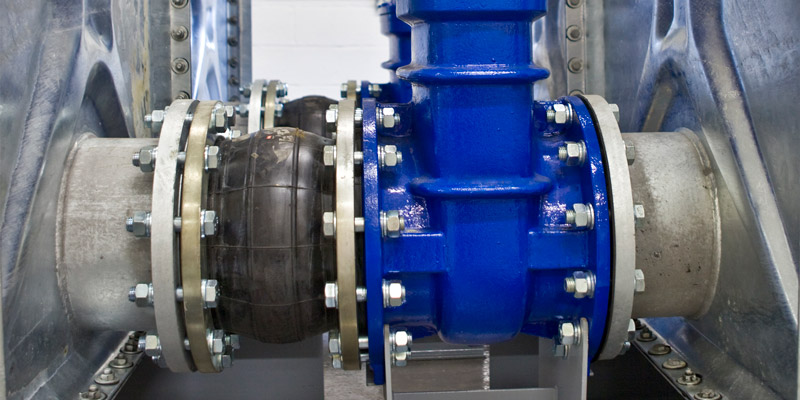Impact of Infrastructure Management on the Contamination of Drinking Water with Pathogens
Principal Investigator - Michèle Prévost, Ecole Polytechnique Montréal (2001-2004)

Challenge
In the United-States, a study from the American Water Works Association (2001) estimates that approximately 250 billion ($US) will be needed over the next 30 years to replace drinking water system components. Canadian municipalities have also expressed the need to rehabilitate critical water infrastructure. The City of Montreal estimated that almost four billion dollars will be necessary to update its drinking water distribution system in the near future. Given these large expenditures, utilities need to be able to maximize their return on investment by prioritizing the most pressing issues.
This research examined the operations and design of distribution systems to direct investments to improve integrity and reduce vulnerability to failure and the effect of intrusion on water quality. Results from this research benefit municipalities, industry, the engineering community and regulatory agencies, to inform revision of drinking water quality regulations, define best practice procedures to be implemented, and support the design and operations of safer systems.
Project
This project examined the impact of infrastructure operation and management on pathogen contamination in water distribution systems, as well as the effect of transient low pressures on pathogen intrusion. One study characterized the type and distribution of deposits found in water mains of 3 distribution systems, measuring the accumulation and nature of deposits, particularly the microbiological colonization. The research evaluated a technique called unidirectional flushing (UDF) to remove deposits, taking samples to analyze quantity (TSS and turbidity), composition (organic matter and minerals) and microbial content. They found that although deposits contained important quantities of bacteria and microorganisms (average of 1010 cells/g) they rarely contained coliforms (only 0.2 % of the samples). Researchers also studied the causes of turbidity complaints in 4 distribution systems using a data mining approach. The research team developed an Interactive Analyzer tool to track the main causes of aesthetic complaints, allowing the user to query the different types of data and produce GIS maps with the corresponding information.
Part of the research developed protocols to assess the impact of some operational activities (pump startup and shut down, repairs of pipe leaks) on water quality and field evaluation of water quality parameter variations during these activities. They found that during pipe repair, the impact on water quality is not limited to the isolated section of main. The team then developed and applied a methodology that demonstrated contaminant intrusion of microbial indicators during a break repair.
Outputs
- Development of an Interactive Analyzer tool to track the main causes of aesthetic complaints, allowing the user to query the different types of data and produce GIS maps with the corresponding information.
- Development and application of a methodology that led to the first demonstration of actual contaminant intrusion of microbial indicators into a full scale distribution system. These findings provided evidence that transient pressures during a break repair may lead to intrusion of micro-organisms.
- The research identified causes of aesthetic complaints using the integrated approach, demonstrating variation between cities due to distribution system characteristics and management regimes. Using numerous municipalities, they were able to compare the impact of different operating factors between distribution systems.
Numerous presentations were given to water utilities to ensure that effective knowledge transfer took place. Researchers produced numerous academic papers detailing their results, and presented their work at provincial, national and international conferences.
Presentations
- Besner, M.C., Gauthier, V., Morissette, C. & Prévost, M. (2002). “Identification des causes principales d’apparition de coliformes dans un réseau de distribution”. Presented at Salon des Technologies Environnementales – Réseau Environnement, April 12, Quebec, Que.
- Prévost, M. (2003). L’approche de qualité globale dans la production d’eau potable au Québec. Presented at Americana 2003, March 19-21, Montreal, Que.
- Fernandes, C. with Karney, B. (2002), “Water Quality Implications under Unsteady Laminar Flow Conditions,” presented at Water 2002, EWRI Conference, ASCE, Roanoke, May.
- Karney, B.W. (2002). “Water Quality Implications of Transient Events in Distribution Systems.” Presentation to Centre for Modelling in Water Engineering, Adelaide Australia, 15 April. Also presented at Hong Kong University of Science and Technology, Hong Kong, 22 April.
- Carrière, A., Barbeau, B., Gauthier, V., Morissette, C., Millette, R. & Lalumière, A. (2002). “Unidirectional flushing: loose deposits characterization in test-zones of three Canadian distribution systems”. In proc. of AWWA WQTC, Nov 10-13, Seattle, WA.
- Fernandes, C. and Karney, B. (2001). “Numerical Solution of the Advection-Dispersion-Reaction Equation Under Transient Hydraulic Conditions,” 29th IAHR Congress, Beijing, September.
- Gauthier, V., Besner, M.C., Barbeau, B., Trépanier, M., Millette, R. and Prévost, M. (2001a) Tracking the source for microbial contamination in distribution system using an integrated approach, p. 14, Nashville, Tennessee, USA.
- Gauthier, V., Besner, M.C., Trépanier, M. and Prévost, M. (2001b) An integrated approach to understand water quality failures in distribution systems, San Diego, California, USA.
- Jaeger, Y., Gauthier, V., Besner, M.C., Toulorge, R., Lemaire, É., de Roubin, M.-R. and Gagnon, J.-L. (2001) An integrated approach to assess the causes water quality failures in the distribution system of Caen, p. 10, Berlin, Germany.
- Lake, R., Miller, K., Besner, M.C., Trépanier, M., Rompré, A. and Gauthier, V. (2001) A comprehensive approach for predicting coliforms in drinking water distribution system, p. 14, York, United Kingdom.
- Besner, M.C., Gauthier, V., Morissette, C. and Prévost, M. (2002b) Identification of the main causes of total coliforms in a distribution system, p. 22, Seattle, Washington, USA.
- Besner, M.C., Carrière, A., Prévost, M. and Martel, K.D. (2003a) Use of data integration to identify the causes of customer complaints in distribution systems, p. 14, Philadelphia, Pennsylvania, USA.
- Besner, M.C., Gauthier, V., Trépanier, M., Nicholson, E. and Desjardins, R. (2003b) Study of water quality variations in the Moncton (New-Brunswick) distribution system using an integrated approach, p. 14, Moncton, New Brunswick, Canada.
- Prévost, M. and Besner, M.C. (2003) Impact of infrastructure management on the contamination of drinking water with pathogens, St-John, Canada.
- Besner, M.C., Cartier, C., Morissette, C., Karney, B., Payment, P. and Prévost, M. (2004a) Do routine distribution system operations have an impact on water quality? (Poster), p. 1, San Antonio, Texas, USA.
- Besner, M.C., Cartier, C., Morissette, C., Aubin, A., Payment, P. and Prévost, M. (2005a) Water quality variations during repairs of pipe leaks, Quebec City, Quebec, Canada.
- Besner, M.C., Cartier, C., Prévost, M., Payment, P. and Morissette, C. (2005b) Repairs of pipe leaks: what is the impact on water quality? (Poster), Kananaskis, Alberta, Canada.
- Cartier, C., Besner, M.C., Lavoie, J., Aubin, A., Payment, P. and Prévost, M. (2005) Étude des possibilités d’intrusions dans les réseaux de distribution d’eau potable lors des réparations de conduites, p. 27, Sherbrooke, Québec, Canada.
- Besner, M.C., Cartier, C., Prévost, M., Lavoie, J., Aubin, A. and Payment, P. (2006) Water main repairs and their impact on water quality, p. 9, St-John, New Brunswick, Canada.
- Besner, M.C., Gauthier, V., Servais, P. and Camper, A. (2005c) Water Quality in the Distribution System. Lauer, W.C. (ed), pp. 27-64, American Water Works Association (AWWA), Denver, Colorado, USA.
Publications and book chapters
- Besner, M.C., Gauthier, V., Barbeau, B., Millette, R., Chapleau, R. and Prévost, M. (2001) Understanding distribution system water quality. Journal of the American Water Works Association 93(7), 101-114.
- Besner, M.C., Gauthier, V., Servais, P. and Camper, A. (2002) Explaining the occurrence of coliforms in distributions systems. Journal of the American Water Works Association 94(8), 95-109.
- Jaeger, Y., Gauthier, V., Besner, M.C., Viret, B., Toulorge, R., Lemaire, É., de Roubin, M.-R. and Gagnon, J.-L. (2002) An integrated approach to assess the causes of water quality failures in the distribution system of Caen. Water Science and Technology: Water Supply 2(3), 243-250.
- Stoianov, I., Karney, B., Covas, D., Maksimovic, C. and Graham, N. (2001). “Wavelet processing of transient signals for pipeline leak location and quantification.” In: Water Software Systems: theory and applications. (Ed. B. Ulanicki, B. Coulbeck and J. Rance). 2, 65-76.
- Besner, M.C., Gauthier, V., Servais, P. and Camper, A. (2005) Water Quality in the Distribution System. Lauer, W.C. (ed), pp. 27-64, American Water Works Association (AWWA), Denver, Colorado, USA.
- Tang, K., Karney, B. and Brunone, B. (2001). “Leak detection using inverse transient calibration and GA – some early success and future challenges.” In Water Software Systems: theory and applications. (Ed. B. Ulanicki, B. Coulbeck and J. Rance). 2, 55-64.
Outcomes
- Changes in practice as, through this research, a participating utility adopted the Interactive analyzer tool, integrating GIS address data into the operational databases so utility personnel could then spatialize data as it is recorded. This approach and tools allowed for direct access to multiple types of data that are typically dispersed in multiple municipal departments.
- The data mining approach and the Interactive Analyzer tool was provided to all participating utilities and tested in a number of European water utilities managed by Veolia Water. It was also used in a study sponsored by AWWARF (American Water Works Association Research Foundation) with utilities in Cincinnati and Denver.
- Additional CWN-supported research has continued to build on findings of this project with an expanded team of researchers and utilities to further investigate the relationship between system hydraulics, maintenance operation and water quality, both at the pilot- and full-scale levels in four Canadian water utilities.




